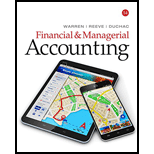
Financial & Managerial Accounting
14th Edition
ISBN: 9781337119207
Author: Carl Warren, James M. Reeve, Jonathan Duchac
Publisher: Cengage Learning
expand_more
expand_more
format_list_bulleted
Concept explainers
Question
Chapter 13, Problem 13.14EX
To determine
Statement of
To Indicate: The items to be reported on the statement of cash flows.
Expert Solution & Answer
Want to see the full answer?
Check out a sample textbook solution
Students have asked these similar questions
What is the economic order quantity?
PLEASE help do thi correctly
During FY 2005 Tenfold Manufacturinghad total manufacturing bycosts are $438,000. Their cost of goods manufactured for the year was $548,000. The January 1, 2006 balance of the Work-in-Process Inventory is $39,000. Use this information to determine the dollar amount of the FY 2005 beginning Work-in-Process Inventory.
Chapter 13 Solutions
Financial & Managerial Accounting
Ch. 13 - Prob. 1DQCh. 13 - Prob. 2DQCh. 13 - A corporation issued 2,000,000 of common stock in...Ch. 13 - A retail business, using the accrual method of...Ch. 13 - If salaries payable was 100,000 at the beginning...Ch. 13 - Prob. 6DQCh. 13 - A corporation issued 2,000,000 of 20-year bonds...Ch. 13 - Fully depreciated equipment costing 50,000 was...Ch. 13 - Prob. 9DQCh. 13 - Name five common major classes of operating cash...
Ch. 13 - Classifying cash flows Identify whether each of...Ch. 13 - Prob. 13.2BECh. 13 - Prob. 13.3BECh. 13 - Prob. 13.4BECh. 13 - Land transactions on the statement of cash flows...Ch. 13 - Common stock transactions on the statement of cash...Ch. 13 - Prob. 13.7BECh. 13 - Prob. 13.8BECh. 13 - Prob. 13.1EXCh. 13 - Effect of transactions on cash flows State the...Ch. 13 - Classifying cash flows Identify the type of cash...Ch. 13 - Prob. 13.4EXCh. 13 - Prob. 13.5EXCh. 13 - Cash flows from operating activitiesindirect...Ch. 13 - Cash flows from operating activitiesindirect...Ch. 13 - Prob. 13.8EXCh. 13 - Reporting changes in equipment on statement of...Ch. 13 - Prob. 13.10EXCh. 13 - Determining cash payments to stockholders The...Ch. 13 - Prob. 13.12EXCh. 13 - Reporting land acquisition for cash and mortgage...Ch. 13 - Prob. 13.14EXCh. 13 - Prob. 13.15EXCh. 13 - Prob. 13.16EXCh. 13 - Statement of cash flowsindirect method The...Ch. 13 - Statement of cash flowsindirect method List the...Ch. 13 - Prob. 13.19EXCh. 13 - Prob. 13.20EXCh. 13 - Cash flows from operating activities direct method...Ch. 13 - Prob. 13.22EXCh. 13 - Prob. 13.1APRCh. 13 - Prob. 13.2APRCh. 13 - Prob. 13.3APRCh. 13 - Prob. 13.4APRCh. 13 - Statement of cash flows direct method applied to...Ch. 13 - Statement of cash flowsindirect method The...Ch. 13 - Statement of cash flows indirect method The...Ch. 13 - Statement of cash flowsindirect method The...Ch. 13 - Statement of cash flows direct method The...Ch. 13 - Statement of cash flowsdirect method applied to PR...Ch. 13 - Prob. 1ADMCh. 13 - Prob. 2ADMCh. 13 - Prob. 3ADMCh. 13 - Priceline: Free cash flow Priceline Group, Inc. is...Ch. 13 - Prob. 13.1TIFCh. 13 - Prob. 13.3TIF
Knowledge Booster
Learn more about
Need a deep-dive on the concept behind this application? Look no further. Learn more about this topic, accounting and related others by exploring similar questions and additional content below.Similar questions
- Natalie Systems had assets of $310,000 and liabilities of $165,000 at the beginning of the year. During the year, revenues were $158,000 and expenses were $102,000. Also, during the year the business paid the owners a dividend of $6,000, and assets increased by $18,000. What were Natalie's total liabilities at the end of the year?arrow_forwardQuartz Manufacturing completes job #715, which has a standard of 480 labor hours at a standard rate of $19.50 per hour. The job was completed in 510 hours and the actual average labor rate was $20.10 per hour. What is the labor rate variance? (A negative number indicates a favorable variance and a positive number indicates an unfavorable variance.)arrow_forwardI need help solving this general accounting question with the proper methodology.arrow_forward
arrow_back_ios
SEE MORE QUESTIONS
arrow_forward_ios
Recommended textbooks for you
 Managerial AccountingAccountingISBN:9781337912020Author:Carl Warren, Ph.d. Cma William B. TaylerPublisher:South-Western College Pub
Managerial AccountingAccountingISBN:9781337912020Author:Carl Warren, Ph.d. Cma William B. TaylerPublisher:South-Western College Pub Intermediate Accounting: Reporting And AnalysisAccountingISBN:9781337788281Author:James M. Wahlen, Jefferson P. Jones, Donald PagachPublisher:Cengage Learning
Intermediate Accounting: Reporting And AnalysisAccountingISBN:9781337788281Author:James M. Wahlen, Jefferson P. Jones, Donald PagachPublisher:Cengage Learning Cornerstones of Financial AccountingAccountingISBN:9781337690881Author:Jay Rich, Jeff JonesPublisher:Cengage Learning
Cornerstones of Financial AccountingAccountingISBN:9781337690881Author:Jay Rich, Jeff JonesPublisher:Cengage Learning

Managerial Accounting
Accounting
ISBN:9781337912020
Author:Carl Warren, Ph.d. Cma William B. Tayler
Publisher:South-Western College Pub


Intermediate Accounting: Reporting And Analysis
Accounting
ISBN:9781337788281
Author:James M. Wahlen, Jefferson P. Jones, Donald Pagach
Publisher:Cengage Learning

Cornerstones of Financial Accounting
Accounting
ISBN:9781337690881
Author:Jay Rich, Jeff Jones
Publisher:Cengage Learning
The KEY to Understanding Financial Statements; Author: Accounting Stuff;https://www.youtube.com/watch?v=_F6a0ddbjtI;License: Standard Youtube License